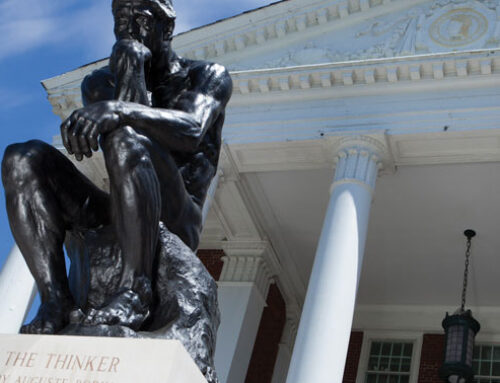By Ben Nance–
Do you enjoy silent films? If your answer to this question is “yes,” then see “The Artist.” If your answer to this question is “no,” then see “The Artist.” If your answer is, “I’ve never seen a silent film,” then for the love of all that is good in the world, please see “The Artist.”
I cannot stress enough how great this movie is, how it transports you in a way no other movie made in the last half-century can. The emotive power of a story told within a silent, black-and-white universe is unmatched, and after experiencing “The Artist” in a theater filled with applause, I can’t help but wonder why it has taken so long to bring that power back to the big screen. Leave your cynical prejudgments at home and give this one a chance. You might find yourself loving it.
“The Artist” is set in a fictionalized version of Hollywood, circa the late 1920s. The world’s most famous silent movie star George Valentin, played by Jean Dujardin, has just premiered his latest film to an ecstatic audience. You can tell from these opening scenes that Valentin loves his fame, but loves the art of entertaining people even more. When called onstage to take a bow, he can’t resist milking the opportunity by performing a series of humorous gags with his canine costar. Valentin later bumps into an eager fan outside the premiere by accident, which leads to a front-page photograph of the encounter and a headline asking, “Who’s that Girl?” That girl is Peppy Miller, played by Berenice Bejo, and her sudden notoriety will gradually propel her to become Hollywood’s new favorite actress. As the era of silent film sadly approaches its end, talking pictures, or “talkies” as they are called, begin to take over. Valentin must deal with the decline of his career and his art in anguish while Peppy continues to thrive in the spotlight as the talkies’ mascot. Their fates are intertwined over the years as the movie industry undergoes an aural revolution.
It seems difficult and exhausting to describe everything I admire about “The Artist,” but here goes:. To start, there’s the ingenious use of intertitles, which only display character dialogue when absolutely necessary. They appear with impeccable comic timing and always in a way that feels earnest and to-the-point. Just wait until the hilarious exclamation of “Toys!” flashes on the screen and the whole theater laughs at the charming cleverness of it.
After a while you feel relieved to discover you don’t need extensive dialogue in order to understand and enjoy the movie’s story, which is better told through priceless facial gestures, symbolic dream sequences, slick dance numbers and an awesome dog. That dog, giving a crowd-favorite performance as Valentin’s pet, steals the show. He is the film’s jester and also its hero.
Jean Dujardin is animated and charismatic as George Valentin. You’d think the guy came straight from a 1929 film lot. The same goes for Berenice Bejo, who does wonders in the role of a multitalented gal born for showbiz. Together, the two make a terrific pair of performers who share a confidence in their ability to captivate an audience. It is also impossible to forget James Cromwell and John Goodman in their minor but fun roles. Cromwell plays Valentin’s loyal butler Clifton, who decides to stick with his friend and boss through the hard times, even if it means sacrificing wages. Goodman, as the opportunistic studio executive Al Zimmer, is more interested in profit than loyalty.
“The Artist” is so much more than “the movie with no talking.” It shows a great passion for classic silent films and, more importantly, captures the indescribable essence of early cinema. You can’t imagine the movie being anywhere near as good with sound or color. Things like the use of painted backdrops in outdoor scenes evoke nostalgia for the picturesque simplicity of Old Hollywood set design. There is also a brilliant inclusion of Bernard Herman’s hypnotic score from “Vertigo.” It comes in at the perfect moment, during a scene that begs for a specific mixture of despair, isolation and paranoia. Despite this emotionally dark segment, “The Artist” is ultimately a joyous celebration of the human spirit, full of life and excitement. That is something worth applauding.
[email protected]
Photo courtesy Warner Brothers




